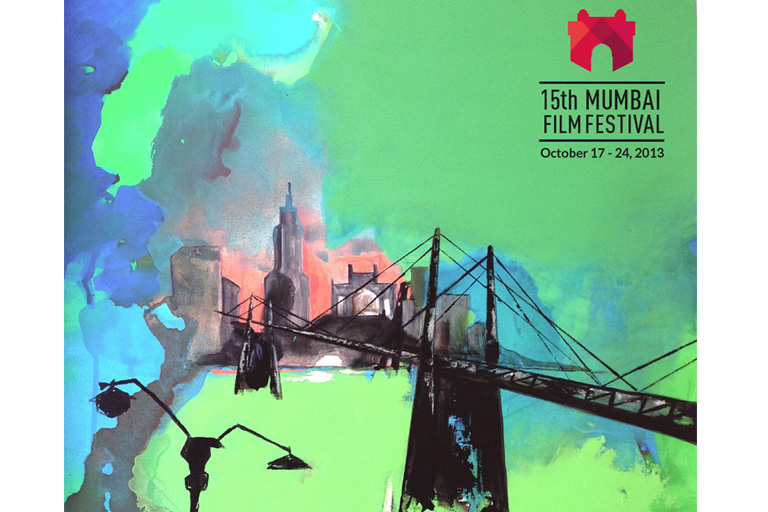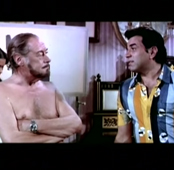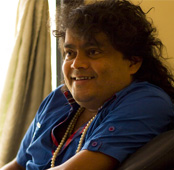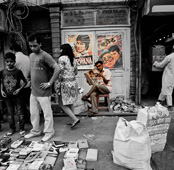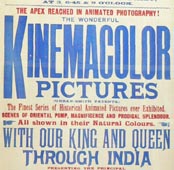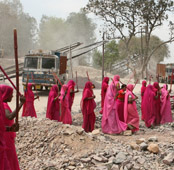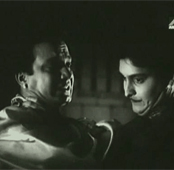TBIP chronicles the life of one of India’s best known film festivals, from its inception till now, through the ups and the downs.
On September 25, 2013, the Mumbai Film Festival’s curtain raiser event was held at the Taj Mahal Palace at Apollo Bunder. Here, in its Crystal Room, the lineup of this year’s festival was announced. Prominent films being screened at the festival were being live-tweeted by @Mumbaifilmfest, the festival’s official twitter handle. One tweet read: “Yes it’s true. Blue Is the Warmest Colour is coming to #MAMI this October!” Blue Is the Warmest Colour won the Palme d’Or at the Festival de Cannes this May. This rather enthusiastic tweet is a fair indicator of the long distance that one of India’s best-known film fests still has to travel. Most of the world’s renowned film festivals, including the Festival de Cannes, take great pride in hosting world premieres for films. They seldom screen films that have already been screened at other festivals. “We are not competing with film festivals either in Asia or in the world,” says Srinivasan Narayanan, Director of the Mumbai Film Festival (MFF, or MAMI as it is often called, after the Mumbai Academy of Moving Image which organizes it), when asked about whether MFF matches up to other leading film festivals. “Our only competition is with ourselves.”
***
On November 24, 1997, the first MFF took off. It was hoped that Mumbai, the city that had never had an independent international film festival to call its own, despite being home to the world’s most prolific film industry, would now play host to ‘good cinema’ from world over. Prior to MFF, the only film festival in the city was the Mumbai International Film Festival (MIFF), but its focus was solely on shorts, documentaries and animation films. Also, back then, the only major film festival in the country was the International Film Festival of India (IFFI). The Kolkata International Film Festival (KFF) was only two years old, and the International Film Festival of Kerala (IFFK) had only had one innings. All of these had been sponsored by the state.
A need was felt for a festival organized by the film industry itself. “Mumbai being the premier filmmaking center in India didn’t have its own festival. We felt an initiative to change that was required, and that’s how we started,” says MAMI trustee, Amit Khanna. So several industry veterans came together to form the Mumbai Academy of Moving Image (MAMI), a not-for-profit trust. Recalls Sudhir Nandgaonkar, former Artistic Director of MFF: “The first ever MAMI meeting was held in April 1997 at Basu Bhattacharya’s home in Carter Road, Bandra. (Filmmakers) Shyam Benegal, Amit Khanna, Kiran Shantaram, Amol Palekar, Basu Bhattacharya, Ramesh Sippy, Manmohan Shetty, and the Film Federation of India (FFI) Secretary General Supran Sen made up that original gathering. And of course, there was the Chairman, Hrishikesh Mukherjee.”
A decision was made to set up the Mumbai Film Festival, an event that would cater to a population starved of world cinema. Hollywood films were already popular in the city, but there was scant exposure to regional films and those from other countries. “Our objective was to change that,” states Kiran Shantaram, former MAMI trustee and Secretary.
In the first few years of the festival, the films screened could be roughly divided into five categories: World Cinema (films screened worldwide in the last two years), contemporary Indian films (with occasional focus on regional films), retrospectives, tributes, and the ‘focus on a country’. The ‘focus on a country’ section endeavoured to “introduce film from a country that the viewer hasn’t seen before.” This section, still there, not only screened films from countries that were usually known world over for producing renowned auteurs—such as Iran, Japan or Spain—it also screened films from countries, whose cinema most were not familiar with, such as Israel, South Africa, Serbia, Montenegro, and Palestine.
Like most film festivals, MFF started small and without a competition section. It showcased 65 films from 23 countries, and its main and only venue, at the outset, was the Y.B. Chavan Centre at Nariman Point. NFDC technicians were brought on board to help check prints and manage screening-related procedures.
Getting by on a budget of Rs. 10 lakhs, the festival barely saw 200 delegates in attendance in its first year. Despite being launched as an independent film festival, Rs. 5 lakhs, or half their budget, had been received as subsidy by the MFF from the state government. “The other 5 (lakhs) came from Mahindra & Mahindra,” says Nandgaonkar.
The festival had many struggles with funding for the first decade. In fact, the state didn’t contribute to the 1998 edition, and the festival had to be cancelled that year.
Also, Air India and Jet Airways were approached to fly down international delegates for free, but only a few tickets for domestic routes were offered. As a result, organizers had to cut down on foreign delegate invites. Kiran Shantaram runs through the list of sponsors: “In 1999, we got Rs. 20 lakhs from Indian Oil (Corporation Ltd.) and Rs. 5 lakhs from the Maharashtra Government. In 2000, Star TV gave Rs. 20 lakhs, Godrej provided Rs.10 lakhs, and the state government increased the annual subsidy from Rs. 5 to 10 lakhs. For the fourth, fifth, and sixth editions, we got Rs. 25 lakhs from Star TV. In 2005, Sahara One contributed Rs. 25 lakhs.” But the backers were still felt to be too few, and the money they pledged wasn’t substantial enough. Nandgaonkar attributes this to the fact that: “In India, corporate companies have no ‘practice’ of supporting a film festival.”
The budgetary concerns were especially relevant because the MAMI trustees wanted the festival to be independent in the truest sense and not kowtow to unpalatable demands from corporate giants. For instance, Pepsi had approached MAMI in 2000 with Rs. 50 lakhs but had wanted to rename the festival the ‘Pepsi Film Festival’. “Of course we declined,” says Nandgaonkar.
In 2006 too, the festival was about to get cancelled due to budgetary constraints, but an intervention with funds from Zee Cinema and AdlabsFilms Ltd. kept it afloat. Even then, it was in such dire straits financially, that there was no cash prize for Indian films that year.
All of this was further exacerbated by the fact that there was no marketing manager for the festival, who could solicit sponsors. The festival couldn’t afford one because of lack of funds. It was a vicious cycle. Then, says Nandgaonkar, “I got a call from Shyam Benegal in 2007 saying, ‘For how long will you toil to support the festival? Why don’t we go to Reliance?’”
Reliance had branched out into the media and entertainment business with Big Entertainment two yearsago, in 2005 (It had acquired Adlabs in July 2005). “The company became a sponsor for the festival in 2007 and 2008, contributing Rs. 1 crore in each year,” says Nandgaonkar. “It was then Tina Ambani suggested that: ‘Instead of sponsoring the festival, why don’t we take over?’”
In 2009, Reliance Big Entertainment officially partnered with MAMI for the 11th edition of the Mumbai Film Festival. The impact was evident. From no cash prize for Indian films in 2006, the total cash prize in 2009 increased to Rs. 85 lakhs. The budget of the festival has since then increased, and is around Rs. 6 crore for the current year, with cash prizes worth more than Rs. 1.2 crore. Also, with the advent of Reliance and a steady source of funds from 2008 on, the festival seemed to be seeking out ways of reinventing itself, of becoming more inclusive.
This can be gauged from the introduction of new sections to the festival, focusing on the younger film enthusiasts of Mumbai. In 2008, MFF introduced ‘Dimensions Mumbai’—a short film competition for filmmakers from Mumbai under the age of 25. In 2009, they launched ‘Mumbai Young Critics’—a film criticism workshop for selected students from various Mumbai colleges, whose critiques got published either in the festival bulletin or the Hindustan Times Café (the festival’s media partner). A jury of young film critics was also formed to confer the ‘Mumbai Young Critics Silver Gateway Award’ upon the best film in the International Competition section. The young are an important ‘target audience’ for the festival. Says Narayanan, to emphasize how important student involvement is: “Besides other reasons (not wanting to clash dates with other major film festivals), the reason we have the festival in October is because at this time of year, schools and colleges are comparatively free, and it’s not exam time.”
The festival also simultaneously introduced awards and sections with more international appeal: a global ‘lifetime achievement award’ was introduced in 2008 (Costa-Gavras will be honoured this year), and, finally, an international competition for first feature films was introduced in 2009. Even the nature of the opening film reflected this new trend. From 2009 on, it wasn’t just about a well-made film, but also one that had a buzz around it. In 2009, the festival opened with Steven Soderbergh’s The Informant, followed by David Fincher’s The Social Network, Bennett Miller’s Moneyball, and David O. Russell’s Silver Linings Playbook in years to come.
MFF has also garnered a lot of attention for the kind of foreign art house films it has screened in the last few years. Films such as The Turin Horse, The Artist, Amour, Beasts of the Southern Wild. Among this year’s screenings will be Blue Is the Warmest Colour, Inside Llewyn Davis and Le Passé to name a few. “They really track the best films that are being shown at various international film festivals,” says Aseem Chhabra, a film critic and writer who curates the New York Indian Film Festival. “To bring the films and significant jurypersons to India, which is still not a premier market for Hollywood and other foreign language films, is a remarkable feat.”
All these films have either been prizewinners or screened in the competition sections of major film festivals of the world. There is a curiosity about them, especially because most of them don’t find a theatrical release in India. And even if they do they are more often than not heavily censored. The interest in these films can also be attributed to a ‘good cinema’ watching culture in the country that is growing slowly but steadily with the proliferation of the internet. “Now people follow what’s happening in other festivals (across the world) online,” says Chhabra. “There’s an audience and they are hungry for good cinema.”
Successful film festivals are also often known by the filmmakers they discover. Filmmakers such as Steven Soderbergh, Quentin Tarantino, Wong Kar-Wai, Jafar Panahi, Darren Aronofsky, and, more recently, Ben Zeitlin all found fame through film festivals. This is possibly one of the reasons behind two of MFF’s new sections— ‘New Faces in Indian Cinema’, a non-competitive section which screens first and second films of Indian filmmakers, was added in 2010, and India Gold, a competitive section comprising Indian films that have not been released elsewhere in the country, in 2012. Aniruddha Guha, Film Editor at Time Out Mumbai, who is part of a 13-member selection panel at MFF, feels MFF has finally made a start at discovering new voices: “Ship of Theseus got a lot of attention this year. I saw Ship of Theseus last year in June, when it was entered into the competition category and it played at the festival where many people watched it, which helped create a lot of buzz.” But, since even films being screened in the India Gold section do not necessarily have to have their world premiere at MFF (something other better known festivals demand) the two acclaimed Indian films that screened at MFF last year—Miss Lovely and Ship of Theseus—were actually first noticed at film festivals abroad (Miss Lovely premiered at the Festival de Cannesand Ship of Theseus premiered at the Toronto International Film Festival).
Most leading film festivals around the world not only screen films that break free from conventional commercial restrictions but also host a kind of ‘art film market’ where such films can be picked up for distribution. MFF too introduced the Mumbai Film Mart in 2011. The objective was “to promote Indian films globally, beyond Bollywood. And also provide a platform for a lot of independent filmmakers,” says Rashmi Lamba, Manager of Mumbai Film Mart. In the last 3 years, the mart has helped release three mainstream Indian films (3 Idiots, Don 2, Jab Tak Hai Jaan) break into non-traditional foreign markets such as Japan. But the modest number of buyers (around 15 in 2011, 25 in 2012, and 50 this year) so far means films from Indian independent filmmakers are still waiting to be picked up.
While there’s no doubting that MFF is highly anticipated today by cinephiles in the city, it is yet to attract a sustained interest from filmmakers across the world. For instance, the filmmaker and leading actors for last year’s opening film, Silver Linings Playbook, besides Anupam Kher, were absent. So were a lot of other international filmmakers whose films screened at the festival. “Why is it that MAMI is not able to attract a lot of journalists for instance? Sure, there will be journalists coming from outside, but why not the kind of press that comes to Toronto or Berlin—500 to 600 journalists from around the world?” asks Chhabra, before answering the question: “But MAMI can’t have that because most of foreign language films that are screened in the festival have already been shown elsewhere.” He adds: “And even though they hold world premieres for Indian films, there’s very little excitement for Indian cinema abroad.”
The Mumbai Film Festival also differs from a lot of international film festivals because of the absence of a permanent venue. Unlike its counterparts in Toronto, Busan, and Venice, MFF has no cultural or cinema complex that serves as a nucleus. This deprives it of a personality. Currently, the film festival resembles a travelling cinema within the city. It kicked off at Y.B. Chavan Centre (Nariman Point) and has since then moved to Marine Lines, Wadala, Versova, Ghatkopar, Juhu, and Sion.
Also, the majority of the screening venues being located in South Bombay makes it difficult for people from far-flung suburbs to attend. Most screenings used to be in South Bombay in the initial years of the festival since its cinema halls were technically equipped, but the mushrooming of multiplexes with better technology has opened up many more possibilities.
“MFF was held at INOX and NCPA (National Centre for the Performing Arts) last year because both are in one area. So we have Metro and Liberty this year,” says Narayanan. But when deciding on venues for a film festival one has to consider both seating capacities as well as their proximity to the audience. The ideal MFF venue should have one cinema with a large seating capacity for the biggest draws, and there should be a multiplex or multiplexes to allow for multiple screenings as well.
Filmmaker Sudhir Mishra, MAMI trustee, reiterates the need for a cultural centre in Bombay: “There should be a facility built by the state for cultural occasions, preferably in a central location like Bandra, so it can be convenient for everyone to visit.” But the dynamics of the space-clogged city poses a logistical challenge to such a permanent venue for the festival.
Perhaps such a venue, with state-of-the-art technology, could help prevent technical glitches of the kind the festival witnessed in the last few years: issues with aspect ratio, missing subtitles, disappearing audio, screening cancellations. When asked about this, Amit Khanna says: “NCPA didn’t have the proper facilities, so temporary facilities were made. This year, we have two engineers from the Society of Motion Picture and Television Engineers of America (SMPTE) coming and helping us.”
Narayanan elaborates on the remedial measures MFF is taking this year to prevent such catastrophes: “We have brought in Real Image and Reliance MediaWorks, and there’s a big technical team working on that. But remember, even festivals like Cannes and Berlin have minor glitches.” Sudhir Mishra also underlines the need for dry runs before films are screened, which he says are already underway this time.
INOX, Nariman Point (one of the venues for last year’s MFF) had come under fire in 2012 for making people stand in line for tickets barely 30 minutes or an hour before films were screened. “They issued tickets for each show instead of letting us get tickets for multiple screenings in a day,” says Deepa Deosthalee, a film writer and last year’s MFF attendee. “It was a huge problem, especially for films that were in demand. I was unable to watch Miss Lovely for this reason.”
Narayanan says: “This was a decision made by the exhibitor, and not MFF”. In an effort to cut down on queues and long waits outside venues this year, MFF has now introduced a seat reservation system. Seats can be pre-booked online against a delegate pass. So now viewers can handpick the films they want to attend and make their bookings— a system followed by international film festivals. Delegates will, however, have to turn up at least 15 minutes before a screening to collect their tickets. MFF hopes this will make things easier for everybody. “If you are not there five minutes before (the film), your reservation will be cancelled,” says Narayanan assertively. Here’s hoping they are, in droves. For when all is noted and said on what makes for a successful film festival, nothing is more significant than its audience.
MAMI – A Retrospective
ArticleOctober 2013
 By Tanul Thakur
By Tanul Thakur
Tanul Thakur is Junior Correspondent at The Big Indian Picture
 By Roshni Nair
By Roshni Nair
Roshni Nair is Trainee Correspondent at The Big Indian Picture


